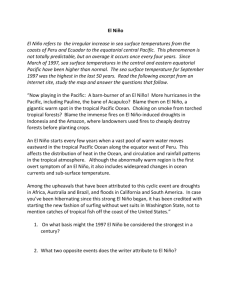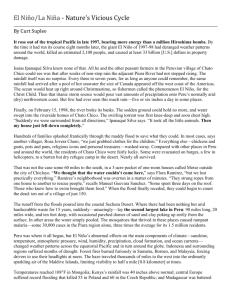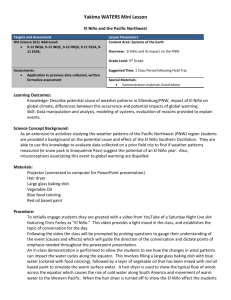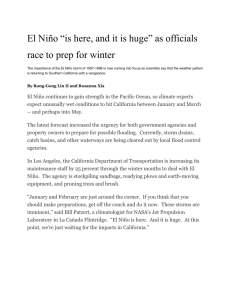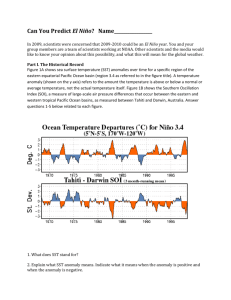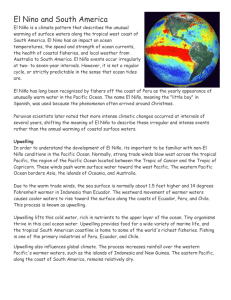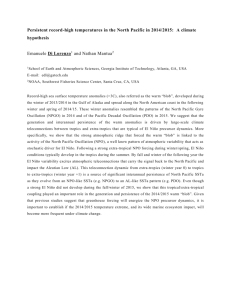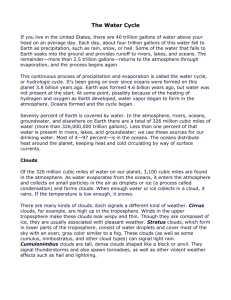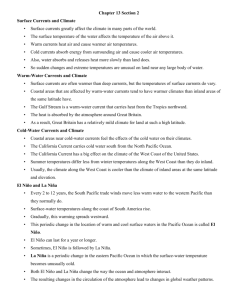Article 2 - cjardines.info
advertisement
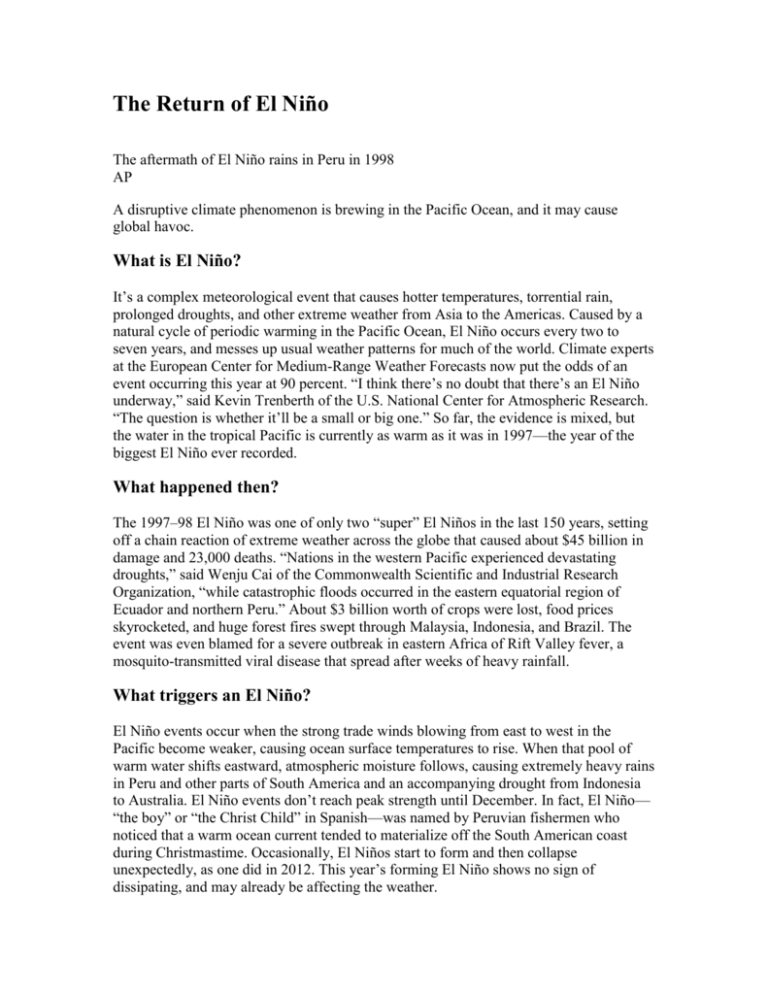
The Return of El Niño The aftermath of El Niño rains in Peru in 1998 AP A disruptive climate phenomenon is brewing in the Pacific Ocean, and it may cause global havoc. What is El Niño? It’s a complex meteorological event that causes hotter temperatures, torrential rain, prolonged droughts, and other extreme weather from Asia to the Americas. Caused by a natural cycle of periodic warming in the Pacific Ocean, El Niño occurs every two to seven years, and messes up usual weather patterns for much of the world. Climate experts at the European Center for Medium-Range Weather Forecasts now put the odds of an event occurring this year at 90 percent. “I think there’s no doubt that there’s an El Niño underway,” said Kevin Trenberth of the U.S. National Center for Atmospheric Research. “The question is whether it’ll be a small or big one.” So far, the evidence is mixed, but the water in the tropical Pacific is currently as warm as it was in 1997—the year of the biggest El Niño ever recorded. What happened then? The 1997–98 El Niño was one of only two “super” El Niños in the last 150 years, setting off a chain reaction of extreme weather across the globe that caused about $45 billion in damage and 23,000 deaths. “Nations in the western Pacific experienced devastating droughts,” said Wenju Cai of the Commonwealth Scientific and Industrial Research Organization, “while catastrophic floods occurred in the eastern equatorial region of Ecuador and northern Peru.” About $3 billion worth of crops were lost, food prices skyrocketed, and huge forest fires swept through Malaysia, Indonesia, and Brazil. The event was even blamed for a severe outbreak in eastern Africa of Rift Valley fever, a mosquito-transmitted viral disease that spread after weeks of heavy rainfall. What triggers an El Niño? El Niño events occur when the strong trade winds blowing from east to west in the Pacific become weaker, causing ocean surface temperatures to rise. When that pool of warm water shifts eastward, atmospheric moisture follows, causing extremely heavy rains in Peru and other parts of South America and an accompanying drought from Indonesia to Australia. El Niño events don’t reach peak strength until December. In fact, El Niño— “the boy” or “the Christ Child” in Spanish—was named by Peruvian fishermen who noticed that a warm ocean current tended to materialize off the South American coast during Christmastime. Occasionally, El Niños start to form and then collapse unexpectedly, as one did in 2012. This year’s forming El Niño shows no sign of dissipating, and may already be affecting the weather. Where is that happening? In India, where June’s monsoon rains are currently 40 percent below average—putting in jeopardy the health of crops in the world’s second-largest producer of sugar, rice, and wheat. If it is El Niño depriving India of its seasonal rains, then the drought would move through Asia and toward Australia, a country that’s already been crippled by a prolonged drought, extreme heat, and raging bushfires. Peru, on the other hand, would experience flooding and a surge in waterborne diseases—as happened when El Niño triggered a cholera epidemic in the country in 1991—and would see its cold-water fisheries depleted by a surge of warm ocean currents. What about the U.S.? We might actually benefit. “El Niño has a bad connotation, undeservedly so in the U.S.,” said Harry Hillaker, state climatologist in Iowa. For one thing, El Niño events tend to increase wind shear in the Atlantic, making it more difficult for hurricanes to form and grow during the June to November season. The phenomenon might also bring a milder winter to the North and East of the U.S., providing relief to locals who have had to suffer through crippling polar vortices. More importantly, the weather event could trigger high rainfall in the drought-ravaged state of California, which in 2013 experienced its driest year in recorded history. The downside of that heavier rainfall is that it could lead to major flash flooding and landslides, says Mike Halpert, the acting director of the federal Climate Prediction Center, but “sometimes you have to pick your poison.” What about climate change? El Niño and climate change are separate phenomena, but they can feed on each other. New research published in the journal Nature Climate Change indicates that unchecked climate change could double the number of El Niño events. In turn, El Niño may exacerbate the effects of global warming: If the 2014 El Niño is as strong as 1998’s, it could rapidly boost global temperatures by nearly 0.25 C, making it the hottest year on record. Some meteorologists think a year of extreme heat could affect long-term climate patterns, triggering more rapid warming for years to come. If a strong El Niño does develop in 2014, the hot weather might affect public opinion about climate change, which has grown more skeptical in recent years. As irrational as it may be, said social scientist Jon Krosnick of Stanford University, millions of Americans form their opinion about climate change “based on very recent trends in warming.’’ And 2014 is shaping up to be an extraordinarily warm year. War-making weather Really bad weather can lead to war. Historians have long suspected that the climate and weather can affect human behavior on a mass scale, but it wasn’t until 2011 that researchers at Columbia University in New York were able to show a link between El Niño and a number of outbreaks of violence from southern Sudan to Indonesia and Peru. Lead researcher Solomon Hsiang estimates that around 50 of the 250 conflicts between 1950 and 2004 were triggered by the El Niño cycle and its resulting loss of crops, jobs, and wealth, and the demanding psychological effects caused by the extreme climate event. “When crops fail, people may take up a gun to make a living,” Hsiang says. His research indicates that a Pacific warming of 0.8 C would raise the annual risk of conflict by 15 percent. Meteorologists currently forecast a Pacific warming of between 0.5 C and 1.5 C for this year. The Week June 27, 2014
